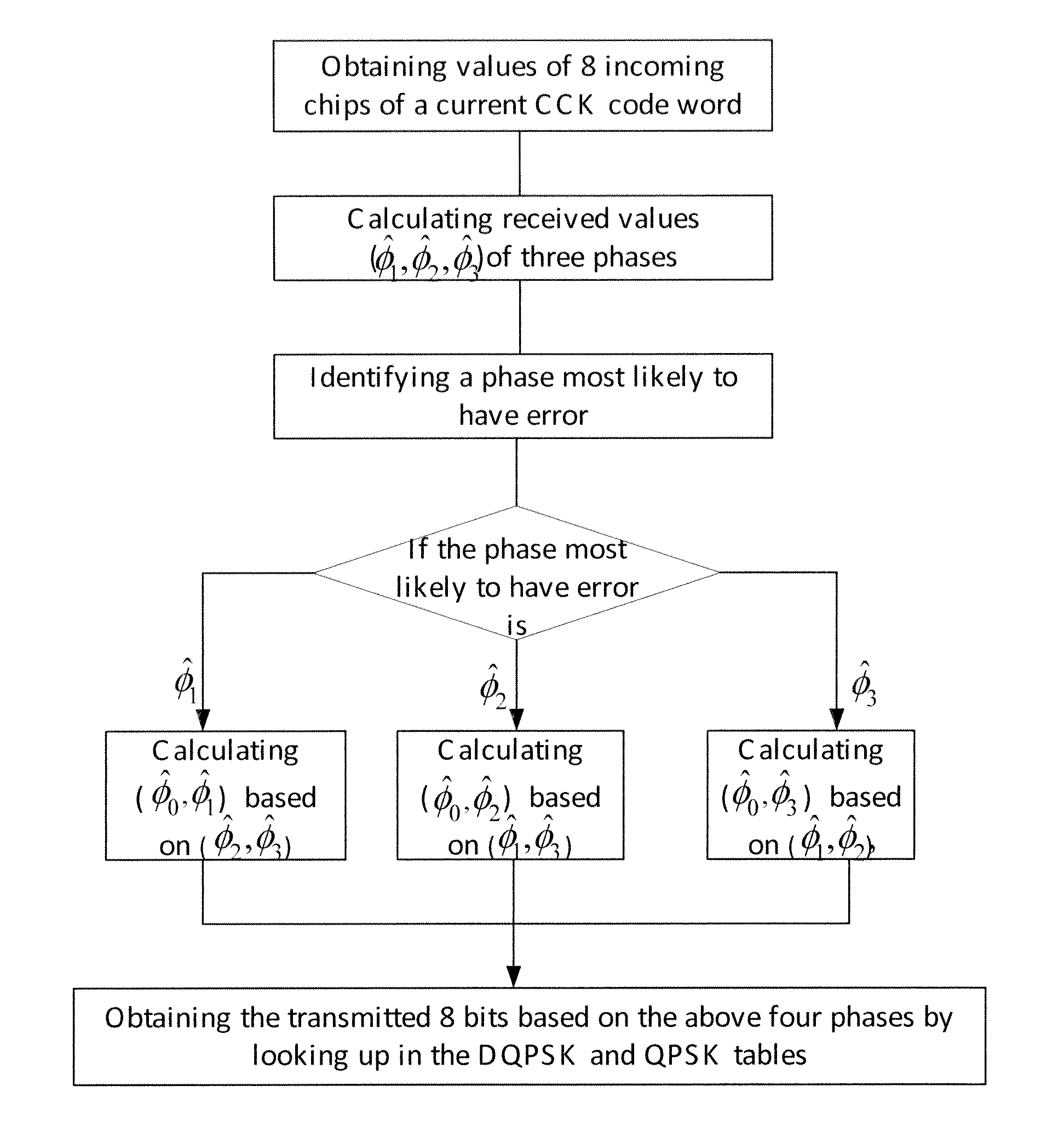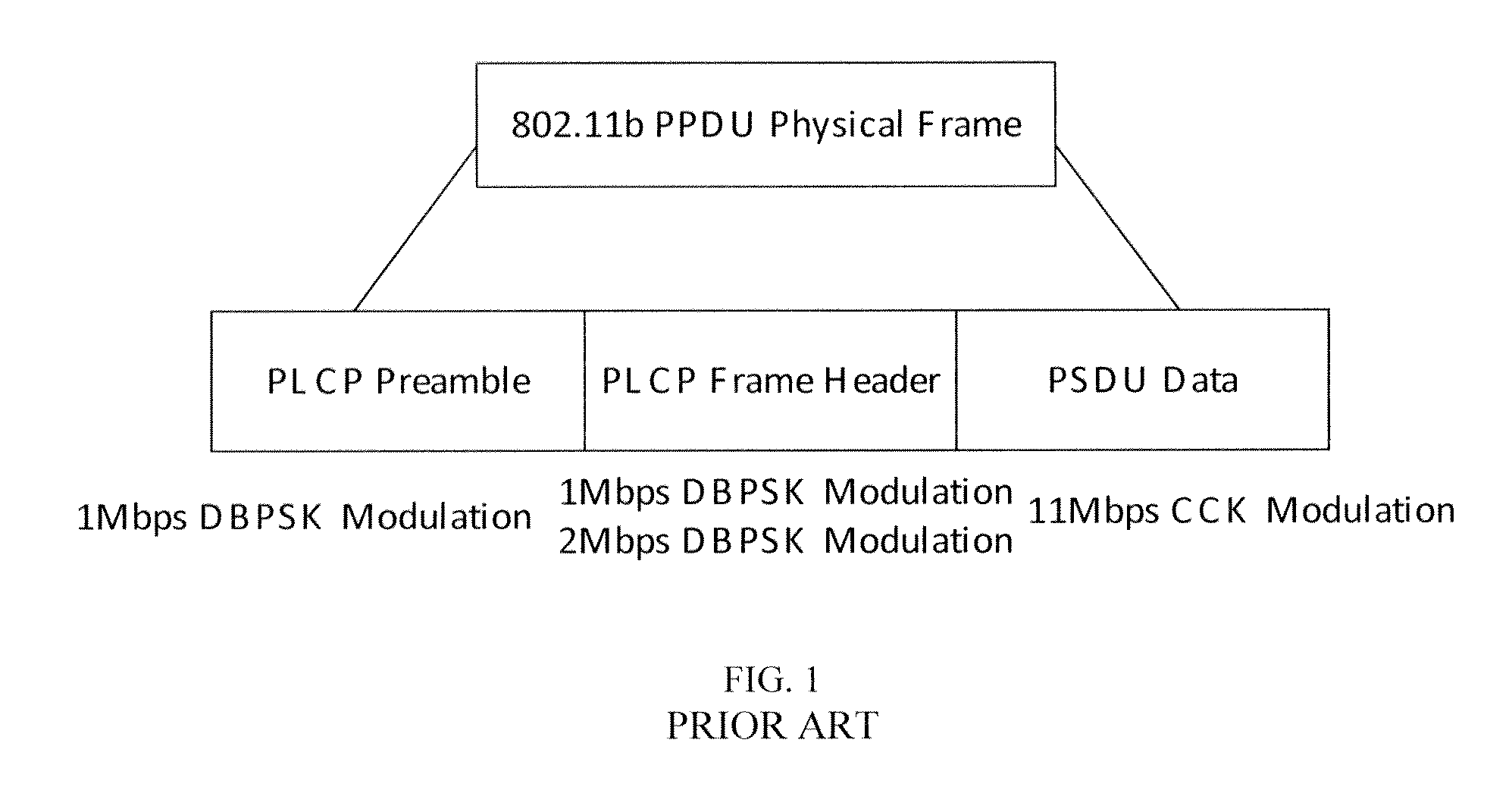Signal Demodulation Method
a signal demodulation and signal technology, applied in the field of signal processing, can solve the problems of poor demodulation performance of cck transmission using this method, large consumption of resources and processing time, etc., and achieve the effect of reducing the effect of noise on signal and improving signal demodulation performan
- Summary
- Abstract
- Description
- Claims
- Application Information
AI Technical Summary
Benefits of technology
Problems solved by technology
Method used
Image
Examples
case 1
[0044] if the most unreliable phase is φ1, then φ1 and φ0 can be determined by equation (4):
exp(j*)=r1*exp(−j*({circumflex over (φ)}2+{circumflex over (φ)}3))−r3*exp(−j*{circumflex over (φ)}3)+r5*exp(−j*{circumflex over (φ)}2)+r7
exp(j*)=r0*exp(−j*({circumflex over (φ)}2+{circumflex over (φ)}3))+r2*exp(−j*{circumflex over (φ)}3)+r4*exp(−j*{circumflex over (φ)}2)−r6
exp(j*)=exp(j*)*exp(−j*{circumflex over (φ)}0) (4)
case 2
[0045] if the most unreliable phase is {circumflex over (φ)}2, then {circumflex over (φ)}2 and {circumflex over (φ)}0 can be determined by equation (5):
exp(j*)=r2*exp(−j*({circumflex over (φ)}1+{circumflex over (φ)}3))−r3*exp(−j*{circumflex over (φ)}3)+r6*exp(−j*{circumflex over (φ)}1)+r7
exp(j*)=r0*exp(−j*(φ1+φ3))+r1*exp(−j*φ3)+r4*exp(−j*φ1)−r5
exp(j*)=exp(j*)*exp(−j*φ0) (5)
case 3
[0046] if the most unreliable phase is {circumflex over (φ)}3, then {circumflex over (φ)}3 and {circumflex over (φ)}0 can be determined by equation (6):
exp(j*)=r4*exp(−j*({circumflex over (φ)}1+{circumflex over (φ)}2))+r5*exp(−j*{circumflex over (φ)}2)−r6*exp(−j*{circumflex over (φ)}1)+r7
exp(j*)=r0*exp(−j*({circumflex over (φ)}1+{circumflex over (φ)}2))+r1*exp(−j*{circumflex over (φ)}2)+r2*exp(−j*{circumflex over (φ)}1)−r3
exp(j*)=exp(j*)*exp(−j*{circumflex over (φ)}0) (6)
[0047]Step 5: look up in tables (Table 1 and Table 2) to obtain incoming bits based on the determination values of the four phases.
[0048]In particular, in this embodiment, corresponding 8 bits can be obtained by looking up in Table 1 (DQPSK Coding) and Table 2 (QPSK Coding) based on the obtained determination values {circumflex over (φ)}i (i=0, 1, 2, 3).
TABLE 1DQPSK Coding(d0, d1)(0, 0)(0, 1) (1, 1)(1, 0)Even Symbol φ00π / 2π3π / 2Odd Symbol φ0 π3π / 20π / 2
TABLE 2QPSK Coding(d2j, d2j +1)(0, 0)(0, 1)(1, 1)(1, 0)φj0π / 23π / ...
PUM
 Login to View More
Login to View More Abstract
Description
Claims
Application Information
 Login to View More
Login to View More - R&D
- Intellectual Property
- Life Sciences
- Materials
- Tech Scout
- Unparalleled Data Quality
- Higher Quality Content
- 60% Fewer Hallucinations
Browse by: Latest US Patents, China's latest patents, Technical Efficacy Thesaurus, Application Domain, Technology Topic, Popular Technical Reports.
© 2025 PatSnap. All rights reserved.Legal|Privacy policy|Modern Slavery Act Transparency Statement|Sitemap|About US| Contact US: help@patsnap.com



